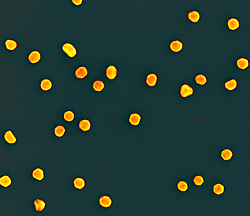Home > Press > NIST Reference Materials Are 'Gold Standard' for Bio-Nanotech Research
 |
| False color scanning electron micrograph (250,000 times magnification) showing the gold nanoparticles created by NIST and the National Cancer Institute’s Nanotechnology Characterization Laboratory (NCL) for use as reference standards in biomedical research laboratories.
Credit: Andras Vladar, NIST |
Abstract:
The National Institute of Standards and Technology (NIST) has issued its first reference standards for nanoscale particles targeted for the biomedical research community—literally "gold standards" for labs studying the biological effects of nanoparticles. The three new materials, gold spheres nominally 10, 30 and 60 nanometers in diameter, were developed in cooperation with the National Cancer Institute's Nanotechnology Characterization Laboratory (NCL).
NIST Reference Materials Are 'Gold Standard' for Bio-Nanotech Research
GAITHERSBURG, MD | Posted on January 9th, 2008Nanosized particles are the subject of a great deal of biological research, in part because of concerns that in addition to having unique physical properties due to their size, they also may have unique biological properties. On the negative side, nanoparticles may have special toxicity issues. On the positive side, they also are being studied as vehicles for targeted drug delivery that have the potential to revolutionize cancer treatments. Research in the field has suffered from a lack of reliable nanoscale measurement standards, both to ensure consistency of data from one lab to the next and to verify the performance of measurement instruments and analytic techniques.
The new NIST reference materials are citrate-stabilized nanosized gold particles in a colloidal suspension in water. They have been extensively analyzed by NIST scientists to assess particle size and size distribution by multiple techniques for dry-deposited, aerosol and liquid-borne forms of the material. Dimensions were measured using six independent methods—including atomic force microscopy (AFM), transmission electron microscopy (TEM), scanning electron microscopy (SEM), differential mobility analysis (DMA), dynamic light scattering (DLS), and small-angle X-ray scattering (SAXS). At the nanoscale in particular, different measurement techniques can and will produce different types of values for the same particles.
In addition to average size and size distributions, the new materials have been chemically analyzed for the concentrations of gold, chloride ion, sodium and citrate, as well as pH, electrical conductivity, and zeta potential (a measure of the stability of the colloidal solution). They have been sterilized with gamma radiation and tested for sterility and endotoxins. Details of the measurement procedures and data are included in a report of investigation accompanying each sample.
NCL examines candidate nanotech cancer drugs developed by biotech firms and academic labs. NCL and the NCI's Alliance for Nanotechnology in Cancer sponsored the NIST work.
Additional technical and ordering information for the new NIST nanoparticle reference materials is available at:
*
RM 8011, Gold Nanoparticles, Nominal 10 nm Diameter https://srmors.nist.gov/view_detail.cfm?srm=8011
*
RM 8012, Gold Nanoparticles, Nominal 30 nm Diameter https://srmors.nist.gov/view_detail.cfm?srm=8012
*
RM 8013, Gold Nanoparticles, Nominal 60 nm Diameter https://srmors.nist.gov/view_detail.cfm?srm=8013
####
About NIST
Founded in 1901, NIST is a non-regulatory federal agency within the U.S. Department of Commerce. NIST's mission is to promote U.S. innovation and industrial competitiveness by advancing measurement science, standards, and technology in ways that enhance economic security and improve our quality of life.
For more information, please click here
Contacts:
Michael Baum, (301) 975-2763
Copyright © NIST
If you have a comment, please Contact us.Issuers of news releases, not 7th Wave, Inc. or Nanotechnology Now, are solely responsible for the accuracy of the content.
| Related News Press |
News and information
![]() Researchers develop molecular qubits that communicate at telecom frequencies October 3rd, 2025
Researchers develop molecular qubits that communicate at telecom frequencies October 3rd, 2025
![]() Next-generation quantum communication October 3rd, 2025
Next-generation quantum communication October 3rd, 2025
![]() "Nanoreactor" cage uses visible light for catalytic and ultra-selective cross-cycloadditions October 3rd, 2025
"Nanoreactor" cage uses visible light for catalytic and ultra-selective cross-cycloadditions October 3rd, 2025
Nanomedicine
![]() New molecular technology targets tumors and simultaneously silences two ‘undruggable’ cancer genes August 8th, 2025
New molecular technology targets tumors and simultaneously silences two ‘undruggable’ cancer genes August 8th, 2025
![]() New imaging approach transforms study of bacterial biofilms August 8th, 2025
New imaging approach transforms study of bacterial biofilms August 8th, 2025
![]() Cambridge chemists discover simple way to build bigger molecules – one carbon at a time June 6th, 2025
Cambridge chemists discover simple way to build bigger molecules – one carbon at a time June 6th, 2025
![]() Electrifying results shed light on graphene foam as a potential material for lab grown cartilage June 6th, 2025
Electrifying results shed light on graphene foam as a potential material for lab grown cartilage June 6th, 2025
Announcements
![]() Rice membrane extracts lithium from brines with greater speed, less waste October 3rd, 2025
Rice membrane extracts lithium from brines with greater speed, less waste October 3rd, 2025
![]() Researchers develop molecular qubits that communicate at telecom frequencies October 3rd, 2025
Researchers develop molecular qubits that communicate at telecom frequencies October 3rd, 2025
![]() Next-generation quantum communication October 3rd, 2025
Next-generation quantum communication October 3rd, 2025
![]() "Nanoreactor" cage uses visible light for catalytic and ultra-selective cross-cycloadditions October 3rd, 2025
"Nanoreactor" cage uses visible light for catalytic and ultra-selective cross-cycloadditions October 3rd, 2025
Safety-Nanoparticles/Risk management
![]() Onion-like nanoparticles found in aircraft exhaust May 14th, 2025
Onion-like nanoparticles found in aircraft exhaust May 14th, 2025
![]() Closing the gaps — MXene-coating filters can enhance performance and reusability February 28th, 2025
Closing the gaps — MXene-coating filters can enhance performance and reusability February 28th, 2025
|
|
||
|
|
||
| The latest news from around the world, FREE | ||
|
|
||
|
|
||
| Premium Products | ||
|
|
||
|
Only the news you want to read!
Learn More |
||
|
|
||
|
Full-service, expert consulting
Learn More |
||
|
|
||








